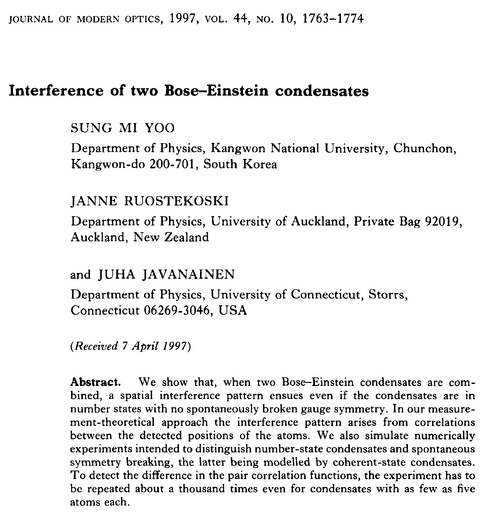Interference of two Bose-Einstein condensates. S. M. Yoo, J. Ruostekoski and J. Javanainen in J. Mod. Opt. 44:1763 (1997). What the paper says!?

This important text details the multiphoton symmetry breaking discussed in the Authors' earlier work[1] («that could not be accommodated by the letter format of our original communication» and which already benefited from
Subsequent developments [16-20] may loosely be summarized by the principle that a measurement looking for an interference pattern will generate a phase, just like a measurement of an observable is always thought to produce one of its eigenvalues.
Their two states are fairly abstract and idealized (indeed the Authors speak of a "thought experiment") being plane waves (cf. with our vortices, which compactify the 1D aspect into a more physical ring).
Interactions are regarded as a problem (causing phase diffusion) instead of a crucial ingredient (to allow condensation):
In order to be able to ignore phase diffusion, we assume that the atoms are non-interacting.
Interestingly, the Authors also had to "rediscover" their wavefunction (the connection to many-body physics was pointed to them by Philip Allen as they mention in their acknowledgements; this shows they indeed have a more quantum-optical minded approach to the problem despite their cold-atom background).
This is not "tedious" in our work:[2]
Here there is a mistake:

Correlations are seen as of the bunching type, to clutter bosons together, unlike our understanding.
In their Section 6, they attempt to distinguish coherent states from Fock states. Here they confuse coherent states with random-phase coherent states. They also find that larger ensembles are required for increasing photon numbers. This goes against our own experience with vortices. They use a quite sophisticated hypothesis-testing procedure on difference of nearest neighbours, so get close to our own geometric features of multiphotons.
Open question:
The obvious question that comes to mind is whether symmetry breaking can lead to predictions that are contrary to experiments. Here we make no attempt to discuss this issue in broad terms. As a practical matter we simply note that in our examples it has proven impossible to distinguish number-state condensates from coherent-state condensates for all but the smallest of atom numbers. Proponents of broken symmetry may always inoculate symmetry breaking against such attempts by insisting that the very concept should be used only in the thermodynamic limit,at large atom numbers.Our quantum ergodic results should answer the above question.
More enigmatic from the point of view of symmetry breaking are questions such as phase diffusion [21-231. Symmetry breaking in itself does not come with a dynamics for the condensate phase. If one insists on symmetry breaking as an independent concept, one has to come up with a dynamics as well. Avoiding such an ad hoc scheme may be the main intellectual advantage of our measurement-theoretical approach that bypasses spontaneous symmetry breaking in its entirety.
Their great conclusion:
Spontaneous symmetry breaking is the general organizing concept in the theory of continuous phase transitions. Nevertheless, it must be recognized as an extra postulate above and beyond statistical mechanics. It should therefore be of some philosophical interest that the characteristic consequences of spontaneous symmetry breaking may be predicted without ever assuming that the state of the system possesses a broken symmetry. Instead, for two condensates it is the process of measurement that generates the import of spontaneous breaking of gauge symmetry. Crudely speaking, if one measures the phase difference of two condensates, one finds a phase difference.